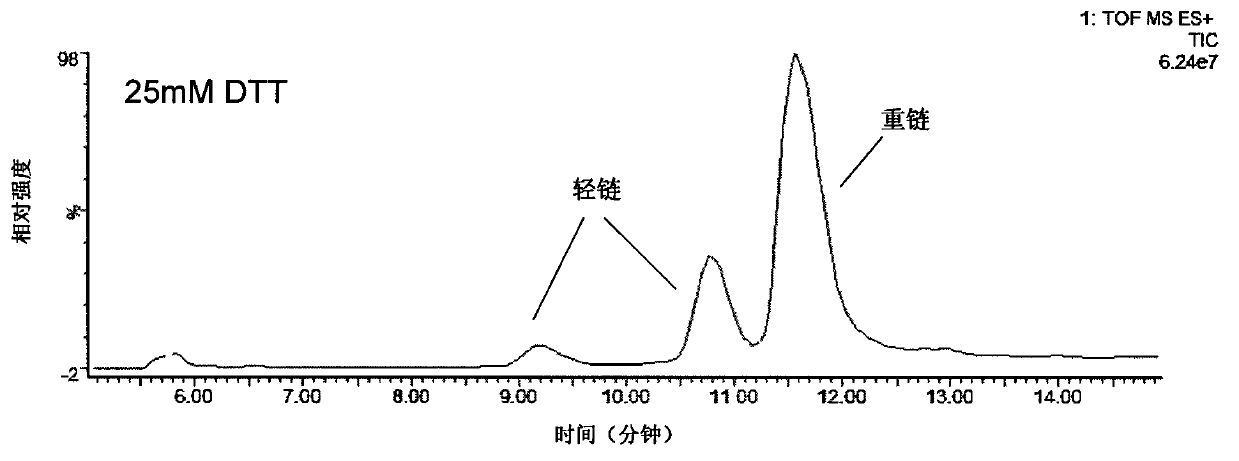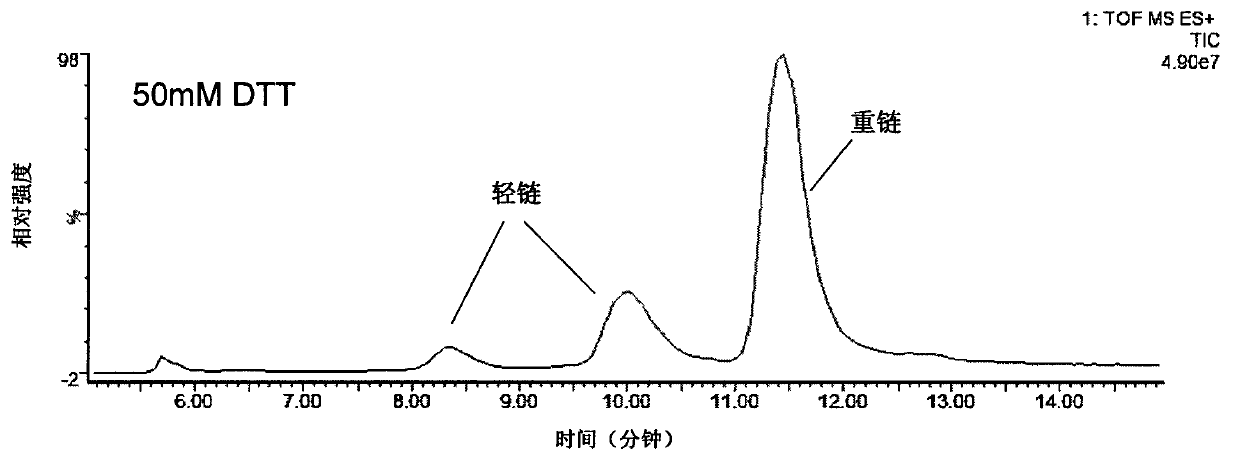Method for determining immunoglobulin charge isomer glycosylation and terminal modification states
An immunoglobulin and charge isomerization technology, applied in the field of glycosylation and terminal modification kits, can solve the problems of high cost, complicated sample processing, and the influence of the original terminal modification of antibodies, and achieves improved accuracy, sample Handling simple effects
- Summary
- Abstract
- Description
- Claims
- Application Information
AI Technical Summary
Problems solved by technology
Method used
Image
Examples
Embodiment 1
[0049] Example 1 Condition screening of immunoglobulin reduction methods
[0050] 1.1 Investigate the dosage of DTT
[0051] The effects of 4 different amounts of DTT on the separation of light and heavy chains were investigated. Take 4 parts of 5μg antibody protein A and add them to 10μL 6M guanidine hydrochloride solution respectively, then add 2μL and 5μL of 0.1M DTT solution, and 2μL and 4μL of 0.5M DTT solution, and finally add an appropriate amount of 6M guanidine hydrochloride solution to make the final concentration of DTT respectively It is 10 mM, 25 mM, 50 mM and 100 mM to react with the IgG1 protein at 65° C. for 45 min.
[0052] The light chain and the heavy chain obtained by the reaction were separated by C4 reverse ultrahigh pressure liquid chromatography, and the liquid system used was UPLC (Waters, ACQUITY). Column: Waters, ACQUITY UPLC column, BEH C4, 1.7μm (particle size), (Aperture), 2.1×50mm. The chromatographic conditions were set as follows: the column temp...
Embodiment 2
[0081] Example 2 Using the UPLC-MS method of the present invention to determine the glycosylation and terminal modification of antibody A and antibody B (IgG1)
[0082] Using optimized reducing conditions (5μg antibody A was added to 10μL 6M guanidine hydrochloride solution, then 0.5M DTT solution 2μL was added, and finally an appropriate amount of 6M guanidine hydrochloride solution was added to make the final concentration of DTT 50mM, and the reaction at 65°C for 45min), UPLC separation (with Consistent with Example 1.1), ESI-MS detection (consistent with Example 1.1) and normalized data processing (consistent with Example 1.2) analyze the glycosylation and terminal modification of antibody A and antibody B. The first amino acid at the N-terminus of antibody A light chain and heavy chain are both glutamine (Gln), which is prone to pyroglutamate cyclization; the first amino acid at the N-terminus of antibody B light chain is glutamate (Glu), which is not prone to occur Pyroglu...
Embodiment 3
[0085] Example 3 The UPLC-MS method of the present invention is used to determine the glycosylation and terminal modification of the charge isomer of antibody A
[0086] Take 200μg of antibody A, add 1μg, 4μg, 10μg and 20μg of carboxypeptidase B respectively, and react at 37°C for about 3 hours. Then use cation exchange chromatography (CEX-HPLC) for analysis; the column can be Dionnex BioLC MAbPac SCX-104×250mm, using mobile phase E (20mM MES and 20mM NaCl) and mobile phase F (20mM MES and 200mM NaCl) for gradient Elution (0-3min, 10-20%F, 3-25min, 20-50%F, 25-38min, 50-70%F, 38-40min, 70%F, 40-42min, 70-10%F , 42-45min, 10% F). The results show that the digestion is insufficient when the amount of carboxypeptidase B is 1 μg and 4 μg, and the digestion is sufficient when the amount of carboxypeptidase B is ≥10 μg, so 10 μg carboxypeptidase B / 200 μg antibody is preferred. In addition, take several portions of 200μg of antibody A, add 10μg of carboxypeptidase B, and react at 37°...
PUM
 Login to View More
Login to View More Abstract
Description
Claims
Application Information
 Login to View More
Login to View More - R&D
- Intellectual Property
- Life Sciences
- Materials
- Tech Scout
- Unparalleled Data Quality
- Higher Quality Content
- 60% Fewer Hallucinations
Browse by: Latest US Patents, China's latest patents, Technical Efficacy Thesaurus, Application Domain, Technology Topic, Popular Technical Reports.
© 2025 PatSnap. All rights reserved.Legal|Privacy policy|Modern Slavery Act Transparency Statement|Sitemap|About US| Contact US: help@patsnap.com



